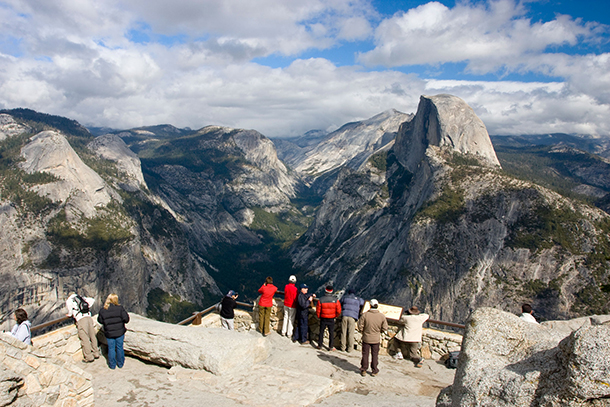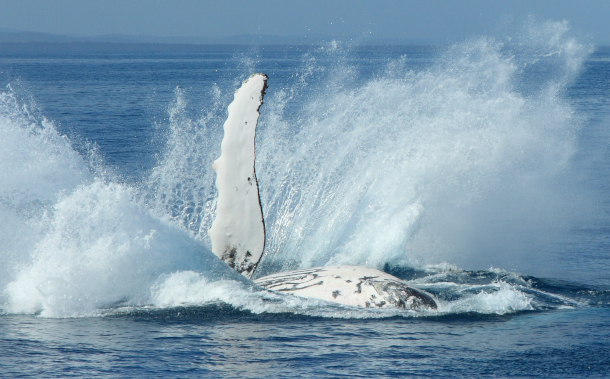Nature on the Federal Balance Sheet
Air Date: Week of March 10, 2023

Natural capital accounting is the process of calculating the dollar value of services provided by nature such as recreation and clean water. (Photo: Taylor Davis, Flickr CC BY-NC-ND 2.0)
The White House is starting to account for natural capital, the economic value of services provided by nature, when making decisions. Linda Bilmes teaches Public Policy and Public Finance at Harvard's Kennedy School of Government and she joins Host Bobby Bascomb to take a look at this emerging strategy.
Transcript
CURWOOD: From PRX and the Jennifer and Ted Stanley Studios at the University of Massachusetts Boston, this is Living on Earth. I’m Steve Curwood.
BASCOMB: And I’m Bobby Bascomb.
The Biden Administration is now working to account for “natural capital” and consider the value of services nature provides when making economic decisions. A standing forest, for example, cleans water, sequesters carbon, and provides critical habitat but often the government doesn’t put a dollar value on trees unless they are cut down and made into paper or lumber. The White House now has a working group that will factor in the monetary value of ecosystem services when looking at the costs and benefits of nature based solutions to address climate change and infrastructure. Linda Bilmes teaches Public Policy and Public Finance at Harvard’s Kennedy School of Government, and is here to explain the new strategy. Linda, welcome back to Living on Earth!
BILMES: Thank you! Delighted to be back.
BASCOMB: So what exactly is being taken into account here? Can you give us a few examples?
BILMES: Yeah, well, right now, the way we measure economic statistics, is we measure economic assets like buildings and factories and machinery and real estate and inventories and things like that. But we don't measure natural assets. So what the Biden administration has now put in place is, for the first time, a national strategy to develop statistics for measuring natural capital. So if you think about a bank, you want to measure how much goes into the bank, and how much comes out of the bank, as well as the point in time of how much you have in your bank account. Now, we want to do this for the environment. So we measure what are our stocks of natural assets like land and soil and fish, and how much we are adding in terms of protecting them and adding to those stocks and how much we are taking out. I mean, if we're trying to think about what is the value of a natural asset, there are a lot of different ways to think about this. But one of the examples that I thought about is the value of a whale. So we all love whales. But how much is a whale worth in terms of what it contributes to the economy. Well, in fact, one whale is worth at least $2 million dollars.
BASCOMB: Why?

A single large baleen whale, like a humpback whale, has been evaluated as worth $2 million. (Photo: Michael Dawes, Flickr, CC BY-NC 2.0)
BILMES: Because the big whales such as sperm whales and filter feeding baleen whales help sequester carbon by hoarding it in their bodies, and they stockpile tons of it like swimming trees. And if you put it into quantitative terms, a mature tree absorbs up to 22 kilograms of carbon each year. But a single whale in its lifespan stores about 33 tons of carbon dioxide, which means that one whale does the job of 1500 trees. And then when a whale dies, its carcass sinks to the bottom of the sea and all the carbon that it's stored circulates in the cycle for hundreds of years, so it becomes a literal carbon sink. And in addition to that, whales provide services called the whale pump, which is that they feed on these tiny marine organisms, such as krill or plankton, which return to the surface in their plumes, which are rich in iron and phosphorus and nitrogen, and which are exactly the substances that feed the plankton cycle. And plankton is important because it captures 40% of all the carbon produced worldwide and half of the oxygen in the atmosphere. So in short, if you compare the commercial value of a whale, which, for example, if Iceland sells a whale to Japan, for whale meat, it can net about $136,000. But just the environmental value of whale, apart from the intrinsic value of the fact that we love whales, is at least $2 million. And if you actually use the EPA's new social cost of carbon, it's about $8 million per whale. So the stock of whales in the ocean is worth trillions of dollars.
BASCOMB: Well, that's the thing, how might we go about monetizing something like a whale to you know, make that appear on our balance sheets as a positive thing?
New #analysis: Less than 3% of the world’s land remains ecologically intact. We can begin to tackle the problem by adopting #naturalcapital accounts using environmental accounting frameworks https://t.co/dkz0Olylk8 @HUCEnvironment @harvarden @GreenHarvard pic.twitter.com/Zlry2knZ8G
— Linda Bilmes (@LJBilmes) May 13, 2021
BILMES: So the Biden administration has put in place a national strategy to develop statistics for environmental economic decisions, which is like a 15 year plan, involving 27 different government agencies to try and put in place a framework for doing exactly what you're talking about. And it's a kind of multi-year effort, which involves, first of all, working with the international frameworks that have been developed, there is something called the UN System of Environmental Economic Accounting, which has been developed by the UN. Over the last 20 years, it has been implemented in a number of countries around the world. But the US has never participated in it, to begin tracking the value of environmental economic assets. So this is the first time that we're actually joining up. So this is a kind of framework for integrating a lot of different data sources. You know, data on energy and air emissions and agriculture and ecosystems and so on to produce integrated accounts that give us a sense of what we have, and to treat such assets as actual assets on balance sheets. Now, it's not always possible to monetize the value. It is pretty much possible to count and to document what we have and to document the degradation. I think we are not even capable of understanding all of the inter linkages between assets and ecosystem services and value. We're also trying to create sort of pilot accounts. To some extent, we have to try different approaches and see how they work and test them out in different sectors. So there is an Office of Federal Statistician that is working with the IMF and other statistical organizations to develop eight separate accounts, the land account, air emissions, environmental activities, marine, water, pollinators, forest and urban green space, which will be like the first eight kinds of accounts. So we start looking at what we have, and what the natural capital accounts look like for those things. So just even heading in this direction, and starting to do it is a big, big amount of progress for the United States.
BASCOMB: In your opinion, why is this a good strategy? Why do we need to put a dollar value on our natural resources?

Linda Bilmes is a Senior Lecturer in public policy at the Harvard Kennedy School and author of Valuing our National Parks: America’s Greatest Investment. (Photo: Diana Bowen/NPS)
BILMES: Natural assets, like land and water and plants, underpin the wellbeing of society, they underpin business, they underpin prosperity, and they underpin economic opportunity. And they help counteract the risks to the environment and risks to market that are caused by climate change and nature loss. So all of those things, I think, are long overdue in society. And we also need to bring together many different groups that don't typically work together. We have to bring together accountants, and economists, and scientists, and geologists, and engineers, and many different types of people and types of professions, which are all in the government, but which just, it's very difficult without a big government push to do this organically. So I think the government has got to lead this effort, which will give us a much much better kind of toolkit with which to think about making wise environmental decisions and protecting biodiversity.
BASCOMB: Linda Bilmes is a Daniel Patrick Moynihan Senior Lecturer Chair in public policy and public finance at Harvard's John F. Kennedy School of Government. Linda, thanks so much for your time today.
BILMES: Thank you so much.
Links
Read the White House’s National Strategy to Develop Statistics for Environmental-Economic Decisions
The Biden Administration’s Fact Sheet on Environmental Economic Decisions
Read more on Natural Capital Accounting
The International Monetary Fund's Article on the Monetary Value of a Whale
Living on Earth wants to hear from you!
Living on Earth
62 Calef Highway, Suite 212
Lee, NH 03861
Telephone: 617-287-4121
E-mail: comments@loe.org
Newsletter [Click here]
Donate to Living on Earth!
Living on Earth is an independent media program and relies entirely on contributions from listeners and institutions supporting public service. Please donate now to preserve an independent environmental voice.
NewsletterLiving on Earth offers a weekly delivery of the show's rundown to your mailbox. Sign up for our newsletter today!
 Sailors For The Sea: Be the change you want to sea.
Sailors For The Sea: Be the change you want to sea.
 The Grantham Foundation for the Protection of the Environment: Committed to protecting and improving the health of the global environment.
The Grantham Foundation for the Protection of the Environment: Committed to protecting and improving the health of the global environment.
 Contribute to Living on Earth and receive, as our gift to you, an archival print of one of Mark Seth Lender's extraordinary wildlife photographs. Follow the link to see Mark's current collection of photographs.
Contribute to Living on Earth and receive, as our gift to you, an archival print of one of Mark Seth Lender's extraordinary wildlife photographs. Follow the link to see Mark's current collection of photographs.
 Buy a signed copy of Mark Seth Lender's book Smeagull the Seagull & support Living on Earth
Buy a signed copy of Mark Seth Lender's book Smeagull the Seagull & support Living on Earth

